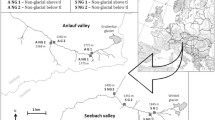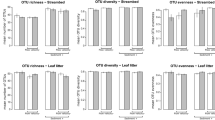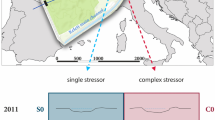Abstract
Macroinvertebrates can be successfully used as biomonitors of pollutants and environmental health because some groups are sensitive whereas, others are relatively tolerant to pollutants. An issue of ongoing debate is what constitutes an appropriate group for biomonitoring; should the group represent species, genera or higher taxonomic levels? A phylogenetic framework can provide new insights into this issue. By developing phylogenies for chironomids and mayflies, this investigation shows that there is strong phylogenetic signal for pollution responses, and that phylogenetic nodes are common to tolerant and sensitive groups of species. A phylogenetic analysis of biotic indices developed for mayflies based on their response to organic pollution shows that mayfly families varied in pollution tolerance. In contrast, based on sediment zinc concentrations as an indicator of pollution tolerance, Australian chironomids tend to vary in tolerance at lower taxonomic levels. Published data on North American chironomids shows much of the signal for pollution responses is contained within genera rather than sub-families. Tools are now available to distinguish whether this signal reflects historical evolutionary constraints or environmental effects leading to common evolved responses. This suggests that ideally higher taxonomic levels should be used for biomonitoring when there are strong phylogenetic constraints at higher levels. Evolutionary considerations can therefore help to guide the development of macroinvertebrate biomonitors and provide insights into processes that produce sensitive and tolerant taxa.



Similar content being viewed by others
References
Akaike H (1973) Maximum likelihood identification of Gaussian autoregressive moving average models. Biometrika 60(2):255–265. doi:10.1093/biomet/60.2.255
ANZECC/ARMCANZ (2000) Australian and New Zealand guidelines for fresh and marine water quality. Australia Water Association, Artarmon, NSW, Australia
Armitage PD, Moss D, Wright JF, Furse MT (1983) The performance of new biological water quality score system based on macroinvertebrates over a wide range of unpolluted running waters. Water Res 17:333–347. doi:10.1016/0043-1354(83)90188-4
Bahrndorff S, Ward J, Pettigrove V, Hoffmann AA (2006) A microcosm test of adaptation and species specific responses to polluted sediments applicable to indigenous chironomids (Diptera). Environ Pollut 139(3):550–560. doi:10.1016/j.envpol.2005.05.024
Bailey RC, Norris RH, Reynoldson TB (2001) Taxonomic resolution of benthic macroinvertebrate communities in bioassessment. J North Am Benthol Soc 20:280–286. doi:10.2307/1468322
Barbour MT, Yoder CO (2000) The multimetric approach to bioassessment, as used in the United States of America. In: Wright JF, Sutcliffe DW, Furse MT (eds) Assessing the biological quality of fresh waters RIVPACS and other techniques. Freshwater Biological Association, The Ferry House, Far Sawrey, Ambleside, Cumbria, UK
Barbour MT, Gerritsen J, Snyder BD, Stribling JB (1999) Bioassessment protocols for use in streams and wadeable rivers: periphyton, benthic macroinvertebrates and fish, second edition. EPA 841-B-99-002. U.S. Environmental Protection Agency, Office of Water, Washington, DC
Beavan L, Sadler J, Pinder C (2001) The invertebrate fauna of a physically modified urban river. Hydrobiologia 445(1–3):97–108. doi:10.1023/A:1017584105641
Benson DA, Karsch-Mizrachi I, Lipman DJ, Ostell J, Sayers EW (2009) GenBank. Nucleic Acids Res 37(suppl 1):D26–D31. doi:10.1093/nar/gkn723
Blomberg S, Theodore Garland J, Ives A (2003) Testing for phylogenetic signal in comparative data: behavioral traits are more labile. Evolution 57(4):717–745. doi:10.1111/j.0014-3820.2003.tb00285.x
Buchwalter DB, Cain DJ, Martin CA, Xie L, Luoma SN, Garland T (2008) Aquatic insect ecophysiological traits reveal phylogenetically based differences in dissolved cadmium susceptibility. Proc Natl Acad Sci 105(24):8321–8326. doi:10.1073/pnas.0801686105
Carew ME, Pettigrove V, Cox RL, Hoffmann AA (2007a) DNA identification of urban Tanytarsini chironomids (Diptera:Chironomidae). J North Am Benthol Soc 26(4):587–600. doi:10.1899/06-120.1
Carew ME, Pettigrove V, Cox RL, Hoffmann AA (2007b) The response of Chironomidae to sediment pollution and other environmental characteristics in urban wetlands. Freshw Biol 52:2444–2462. doi:10.1111/j.1365-2427.2007.01840.x
Chessman BC (1995) Rapid assessment of rivers using macroinvertebrates: a procedure based on habitat-specific sampling, family level identification and a biotic index. Aust J Ecol 20:122–129. doi:10.1111/j.1442-9993.1995.tb00526.x
Chessman BC (2003) New sensitivity grades for Australian river macroinvertebrates. Mar Freshw Res 54(2):95–103. doi:10.1071/MF02114
Chessman BC, McEvoy PK (1998) Towards diagnostic biotic indices for river macroinvertebrates. Hydrobiologia 364(2):169–182. doi:10.1023/A:1003142819625
Claudianos C, Ranson H, Johnson RM, Biswas S, Schuler MA, Berenbaum MR, Feyereisen R, Oakeshott JG (2006) A deficit of detoxification enzymes: pesticide sensitivity and environmental response in the honeybee. Insect Mol Biol 15(5):615–636. doi:10.1111/j.1365-2583.2006.00672.x
Cliff A, Ord J (1981) Spatial processes: models and applications. Prion, London
Cranston PS (1995) Systematics. In: Armitage PD, Cranston PS, Pinder LCV (eds) The Chironomidae: the ecology and biology of non-biting midges, 1st edn. Chapman and Hall, London, pp 31–52
Diniz-Filho JAF, Sant’Ana CER, Bini LM (1998) An eigenvector method for estimating phylogenetic inertia. Evolution 52:1247–1262. doi:10.2307/2411294
Freckleton RP (2009) The seven deadly sins of comparative analysis. J Evol Biol 22(7):1367–1375. doi:10.1111/j.1420-9101.2009.01757.x
Groenendijk D, Lucker SMG, Plans M, Kraak MHS, Admiraal W (2002) Dynamics of metal adaptation in riverine chironomids. Environ Pollut 117(1):101–109
Growns JE, Davis JA, Cheal F, Schmidt LG, Rosich RS, Bradley SJ (1992) Multivariate pattern analysis of wetland invertebrate communities and environmental variables in Western Australia. Aust J Ecol 17:275–288. doi:10.1111/j.1442-9993.1992.tb00809.x
Hansen TF, Pienaar J, Orzack SH (2008) A comparative method for studying adaptation to a randomly evolving environment. Evolution 62:1965–1977
Hebert PND, Cywinska A, Ball SL, DeWaard JR (2003) Biological identification through DNA barcodes. Proc R Soc Lond B 270:313–321. doi:10.1098/rspb.2002.2218
Hewlett R (2000) Implications of taxonomic resolution and sample habitat for stream classification at a broad geographical scale. J North Am Benthol Soc 19:352–361. doi:10.2307/1468077
Hillis DM, Moritz C, Mable BK (eds) (1996) Molecular systematics, 2nd edn. Sinauer Associates, Sunderland
Hilsenhoff W (1977) Use of arthropods to evaluate water quality of streams. Wisconsin Department of Natural Resources, Madison
Hilsenhoff W (1982) Using a biotic index to evaluate water quality in streams. Wisconsin Department of Natural Resources, Madison
Hilsenhoff W (1987) An improved biotic index of organic stream pollution. Great Lakes Entomol 20(1):31–40
Hilsenhoff W (1988) Rapid field assessment of organic pollution with a family-level biotic index. J North Am Benthol Soc 7(1):65–68
Jones F (2008) Taxonomic sufficiency: the influence of taxonomic resolution on freshwater bioassessments using benthic macroinvertebrates. Environ Rev 16:45–69. doi:10.1139/A07-010
Kembel S, Ackerly D, Blomberg S, Cornwell W, Cowan P (2010) Picante: R tools for integrating phylogenies and ecology. Bioinformatics In press. doi:10.1093/bioinformatics/btq166
King RS, Richardson CJ (2002) Evaluating sub-sampling approaches and macroinvertebrate taxonomic resolution for wetland bioassessment. J North Am Benthol Soc 21(1):150–171. doi:10.2307/1468306
King RS, Richardson CJ (2003) Integrating bioassessment and ecological risk assessment: an approach to developing numerical water-quality criteria. Environ Manag 31(6):795–809. doi:10.1007/s00267-002-0036-4
Kristensen P, Bøgestrand J (1996) Surface water quality monitoring. EEA (European Environomental Angency), National Environmental Research Institute, Copenhagen
Legendre P, Dale MRT, Fortin MJ, Casgrain P, Gurevitch J (2004) Effects of spatial structures on the results of field experiments. Ecology 85(12):3202–3214. doi:10.1890/03-0677
Lenat DR, Resh VH (2001) Taxonomy and stream ecology-the benefits of genus and species level identifications. J North Am Benthol Soc 20:287–289. doi:10.2307/1468323
Losos JB (2008) Phylogenetic niche conservatism, phylogenetic signal and the relationship between phylogenetic relatedness and ecological similarity among species. Ecol Lett 11(10):995–1003. doi:10.1111/j.1461-0248.2008.01229.x
Maddison WP, Maddison DR (2007) Mesquite: a modular system for evolutionary analysis. Version 2.0. Accessed 30 Oct 2010
Maddison WP, Maddison DR (2010) Mesquite: a modular system for evolutionary analysis. Version 2.73 http://mesquiteproject.org
Maher WA, Norris RH (1990) Water quality assessment programs in Australia deciding what to measure, and how and where to use bioindicators. Environ Monit Assess 14:115–130. doi:10.1007/BF00677912
Mandaville SM (2002) Benthic macroinvertebrates in freshwaters—taxa tolerance values, metrics and protocols. Halifax, Canada
Metzeling L, Robinson D, Perriss S, Marchant R (2002) Temporal persistence of benthic invertebrate communities in south-eastern Australian streams: taxonomic resolution and implications for the use of predictive models. Mar Freshw Res 53(8):1223–1234. doi:10.1071/MF02071
Morgan AJ, Kille P, Sturzenbaum SR (2007) Microevolution and ecotoxicology of metals in invertebrates. Environ Sci Technol 41(4):1085–1096. doi:10.1021/es061992x
Ogden TH, Gattolliat JL, Sartori M, Staniczek AH, Soldán T, Whiting MF (2009) Towards a new paradigm in mayfly phylogeny (Ephemeroptera): combined analysis of morphological and molecular data. Syst Entomol 34(4):616–634. doi:10.1111/j.1365-3113.2009.00488.x
Pettigrove V, Hoffmann A (2005) A field-based microcosm method to assess the effect of polluted urban stream sediments on aquatic macroinvertebrates. Environ Toxicol Chem 24(1):170–180. doi:10.1897/03-459.1
Plafkin JK, Barbour MT, Porter KD, Gross SK, Hughes RM (1989) Rapid bioassessment protocols for the use in streams and rivers: benthic macroinvertebrates and fish. Environmental Protection Agency, USA
Posada D, Crandall KA (1998) Modeltest: testing the model of DNA substitution. Bioinformatics 14:817–818. doi:10.1093/bioinformatics/14.9.817
Rambaut A, Drummond A (2007) Tracer v1.4, http://beast.bio.ed.ac.uk/Tracer. Accessed 30 Oct 2010
Resh VH, Unzicker JD (1975) Water quality monitoring and aquatic organisms: the importance of species identification. J Water Pollut Control Fed 47:9–19
Resh VH, Norris RN, Barbour MT (1995) Design and implementation of rapid assessment approaches for water resource monitoring using benthic macroinvertebrates. Aust J Ecol 20(1):108–121. doi:10.1111/j.1442-9993.1995.tb00525.x
Riva-Murray K, Bode RW, Phillips PJ, Wall GL (2002) Impact source determination with biomonitoring data in New York state: concordance with environmental data. Northeastern Naturalist 9(2):127–162. doi:10.1656/1092-6194(2002)009[0127:ISDWBD]2.0.CO;2
Ronquist F, Huelsenbeck JP (2003) MrBayes 3: bayesian phylogenetic inference under mixed models. Bioinformatics 19(12):1572–1574. doi:10.1093/bioinformatics/btg180
Rosenberg DM, Resh VH (1993) Introduction to freshwater biomonitoring and benthic macroinvertebrates. In: Rosenberg DM, Resh VH (eds) Freshwater biomonitoring and benthic macroinvertebrates. Chapman and Hall, New York
Ruse LP (1996) Multivariate techniques relating macroinvertebrate and environmental data from a river catchment. Water Res 30(12):3017–3024. doi:10.1016/S0043-1354(96)00217-5
Simpson JC, Norris RH (2000) Biological assessment of river quality: development of AUSRIVAS models and outputs. In: Wright JF, Sutcliffe DW, Furse MT (eds) Assessing the biological quality of fresh waters RIVPACS and other techniques. Freshwater Biological Association, The Ferry House, Far Sawrey, Ambleside, Cumbria, UK, pp 125–142
Sung D-Y, Kaplan F, Lee K-J, Guy CL (2003) Acquired tolerance to temperature extremes. Trends Plant Sci 8(4):179–187. doi:10.1016/s1360-1385(03)00047-5
Warren DL, Glor RE, Turelli M (2008) Environmental niche equivalency versus conservatism: quantitive approaches to niche evolution. Evolution 62(11):2868–2883. doi:10.1111/j.1558-5646.2008.00482.x
Wiens JJ, Graham CH (2005) Niche conservatism: integrating evolution, ecology, and conservation biology. Annu Rev Ecol Syst 36:519–539
Williams SE, Williams YM, VanDerWal J, Isaac JL, Shoo LP, Johnson CN (2009) Ecological specialization and population size in a biodiversity hotspot: how rare species avoid extinction. Proc Natl Acad Sci USA 106(Supplement 2):19737–19741. doi:10.1073/pnas.0901640106
Wright JD, Armitage PD, Furse MT (1989) Prediction of invertebrate communities using stream measurements. Regulated Rivers 4:147–155. doi:10.1002/rrr.3450040207
Acknowledgments
Our study on pollution monitoring is supported through the Victorian Center for Applied Pollution Investigation and Monitoring, funded by the Victorian Department of Innovation, Infrastructure and Regional Development as well as Melbourne Water and the Department of Primary Industry. We are also supported by a Linkage grant and Fellowships from the Australian Research Council.
Author information
Authors and Affiliations
Corresponding author
Rights and permissions
About this article
Cite this article
Carew, M.E., Miller, A.D. & Hoffmann, A.A. Phylogenetic signals and ecotoxicological responses: potential implications for aquatic biomonitoring. Ecotoxicology 20, 595–606 (2011). https://doi.org/10.1007/s10646-011-0615-3
Accepted:
Published:
Issue Date:
DOI: https://doi.org/10.1007/s10646-011-0615-3




